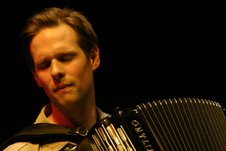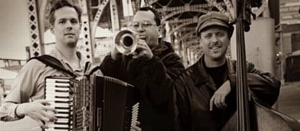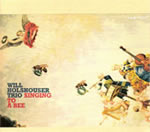Will Holshouser uses jazz, experimental music, and elements of folk to compose intellectually complex but deeply emotional music. This tension between the head and the heart is expressed lovingly by Holshouser’s instrument of choice, the accordion. Consider his piece “Brooklyn Research” from his album Singing to a Bee. The accordion begins as a kind of haunted spectator, the theorist who secretly desires to be an artist. By the end of the composition, the accordion is walking right along with the worldly trumpet, finally giving in to the ordered chaos of the world.
 Clearly indebted to klezmer for the framework of much of his music, Holshouser has toured and recorded with the preeminent clarinetist David Krakauer and his group Klezmer Madness. But his work does not end there. He has also played with Regina Carter, Antony & the Johnsons, Phillip Johnston, Dave Douglas, Andy Statman, Lenny Pickett, the Brooklyn Philharmonic Orchestra, the Orpheus Chamber Orchestra, the New York City Opera, Mark Morris Dance Group, Roberto Rodriguez, the Raymond Scott Orchestrette, and others. Leaving klezmer aside, Holshouser’s musical roots run deepest in jazz and folk, sometimes at the thorny intersection between the two.
Clearly indebted to klezmer for the framework of much of his music, Holshouser has toured and recorded with the preeminent clarinetist David Krakauer and his group Klezmer Madness. But his work does not end there. He has also played with Regina Carter, Antony & the Johnsons, Phillip Johnston, Dave Douglas, Andy Statman, Lenny Pickett, the Brooklyn Philharmonic Orchestra, the Orpheus Chamber Orchestra, the New York City Opera, Mark Morris Dance Group, Roberto Rodriguez, the Raymond Scott Orchestrette, and others. Leaving klezmer aside, Holshouser’s musical roots run deepest in jazz and folk, sometimes at the thorny intersection between the two.
I spoke with Holshouser about klezmer, tradition, the relationship between folk and jazz, and that sweet melancholy instrument, the accordion.
Peter Bebergal: What initially attracted you to the accordion?
Will Holshouser: I had grown up listening to bluegrass and folk music with my parents and got into punk rock and reggae in high school. I played the piano and studied mostly jazz in college. I loved the mysterious effects and pungent sounds of modern jazz, but it seemed to come with a directive to be as complex as possible. I was missing those elements of simplicity and directness. In college, a friend bought me an old accordion at a rummage sale and I fell in love with it. To my ears, it was a new sound and an open territory. I started listening to any record I could find that involved an accordion and I heard an emotional directness in a lot of the music I discovered at that time. The sweet, wheezy sound of was so new to my ears, it was refreshing. Most importantly, it was okay to be simple on the accordion.
PB: Was it difficult to make that bridge between the folk quality of the instrument and the intellectual demands of jazz?
WH: I like to work with those tensions. I don’t think of it as a struggle, but a paradox. I like to use opposing pairs that go well together. Simplicity and complexity in the same piece can highlight each other. When a very plain melody shows up after an abstract moment (or vice versa), that can have a strong effect. Of course, those paradoxes fold out in many ways: instrumental folk music can be complex and edgy, raw, and unschooled, while jazz and modern music can be simple and beautiful.
PB: Your music seems to engage in this tension directly, which in your music sometimes sounds like a struggle between faith and reason, the irrational and the rational.
WH: I don’t think of faith and reason as contradictory, but as two aspects of human experience that can inform each other. (Unfortunately, they often do not). I like to explore that in music. When I write, I look for emotion, but also mystery and surprise. It’s too bad that musicians often take sides along this divide of intellect vs. emotion or craft vs. feeling. Jazz musicians and country musicians often despise each other’s music. Many avant-garde musicians are still reacting against 19th-century Romanticism and aren’t interested in personal expression. For me, the music I like best ignores the divide; it evokes a feeling by getting away from clichés through surprising, interesting sounds.
PB: How did you find yourself involved with klezmer? WH: Klezmer has been a big part of my musical life and an important influence in terms of composing my own accordion music. I first heard klezmer when I discovered the accordion. The first klezmer band I heard, like many people my age, was the Klezmatics. I heard them play in Central Park in New York and liked their irreverent, punk-influenced approach. I was also listening to other accordion music such as Clifton Chenier, Beausoleil, Flaco Jimenez as well as my jazz favorites like Thelonious Monk and Bill Evans. My college rock band was eclectic – we played a little bit of klezmer, among other things, at the Rodeo Bar in New York where my first old accordion fell to pieces on stage one night. We were just playing music we liked, reveling in the different sounds and having fun.
 When I moved to New York for good in 1991, I took any kind of accordion work I could get, including filling in with local klezmer bands. Each band had its own approach to the style. I studied some old records, including those of the Dave Tarras Trio from the 1940s – clarinet, incisively rhythmic accordion, and drums – and some solo records by Mishka Tziganoff.
When I moved to New York for good in 1991, I took any kind of accordion work I could get, including filling in with local klezmer bands. Each band had its own approach to the style. I studied some old records, including those of the Dave Tarras Trio from the 1940s – clarinet, incisively rhythmic accordion, and drums – and some solo records by Mishka Tziganoff.
PB: What was it like playing with David Krakauer?
WH: Joining David Krakauer’s Klezmer Madness band gave me the chance to play klezmer on a regular basis. David’s modern take on the style allowed me to learn it with some freedom to experiment. He uses avant-garde elements to reintroduce the raw edge of the early klezmer recordings, while keeping many traditional structures of the music in place – especially dance rhythms, ornamentation, and doinas (rhapsodic, free-tempo improvisation over a drone). Those keep his music sounding like klezmer.
PB: In what way has klezmer now become part of a musical language for you? WH: Every musician is constantly piecing together his or her own musical vocabulary. Writing my own music gives me a musical center as I soak up nourishment from various playing situations in which I find myself working as a sideman. I write my own kind of accordion music and I often use modern structures, but try to capture the warmth and grit of older musics. I like simple melodies, pulsating rhythms, loud and soft dynamics, modern harmony, and improvisation.
Playing klezmer has certainly changed the way I play the accordion. Among other things, I’ve learned to spit out runs of notes, to play peppery, dry, percussive chords, and to use ornamentation to tease out harmonic color. Many of these musical nuts and bolts are interesting and quirky, but what’s really fascinating is how they create such compelling effects – how they punch through our daily existence and help us to have these musical and emotional experiences that are so fulfilling.
Some more of my favorite things about klezmer are: the doina; the modes, some of which use both a minor and a major third; the chord progressions, which stray from standard western harmony; the ‘happy’ minor-key tunes and ‘plaintive’ major ones, which call into question that old cliché of tonality; the way a melody floats and scoots along independently over a steady dance rhythm; the rich tone and bite of the instruments, the unabashed expressiveness.
Often I’ll use elements like these as jumping-off points or pieces of the puzzle to be rearranged. I like to alter them and see where they lead me. I might take a klezmer-style mode or chord progression, make some changes, put it into a different rhythmic framework, and use that as the basis for a piece. Or I might use some klezmer rhythms in the middle of an otherwise unrelated piece. An improvisation based on some twisty klezmeresque phrases or ornaments might turn into a new tune with a flavor of its own.
PB: How is it that klezmer, something that exists because of Jewish culture, can transcend its culture?
WH: What I enjoy learning from klezmer is not just the techniques, cheap gags and trap doors, as fascinating as they are. What makes them come to life are their mysterious effects – the sense of excitement, the emotional response, suddenly feeling involved in something bigger than oneself. How does music of any genre suspend time and create an atmosphere? These sounds, textures, and expressive qualities of klezmer often thrive outside the context of specifically Jewish culture as they do in the music of George Gershwin, Kurt Weill, Friedrich Hollaender, Raymond Scott, and Serge Gainsbourg… Jewish composers working in pop and jazz idioms.
PB: So Klezmer does have musical themes that work beyond the Jewish cultural context?
WH: In his recent New Yorker article Milan Kundera says that a novel can be seen in the smaller context of a national literature, or the larger context of world literature. It may have certain specific meanings within the national context – small nations, especially, need their artists in order to survive. At the same time, foreign readers can appreciate the nation’s literature in a different way, focusing on the aesthetic and philosophical qualities of a writer’s work rather than the political and social messages aimed at the national readership. Playing klezmer music, I don’t always recognize the in-group Jewish cultural references, but I’m fascinated by learning what makes the music tick and by spending time in its various multi-colored atmospheres.
It’s an odd fact of life in the digital age that many old music styles probably have more listeners today than they ever did in their own times. I feel lucky to live in a time when klezmer music is available to us in all its expressive richness, after almost being wiped out along with the rest of Jewish culture. I’m also lucky to live in New York City where many musical and social worlds overlap and musicians from different backgrounds can compare notes as we put our puzzles together.
PB: While klezmer was initially meant to be a secular music, it still draws from a music language found in the synagogues and liturgy. Do you play with this relationship in your own music?
WH: Yes, definitely. When I was a kid, I loved the feeling that I got listening to hymns in church. The fact that it felt so good was in itself a kind of experience of truth. I felt in touch with something beyond my individual self. I also loved slam dancing at punk rock shows and the sheer energy of that music, which felt like another way of getting beyond the self. Then I got interested in jazz, and the mystery of how improvisation taps into the subconscious. I like to explore all these effects of music, and they seem more real when they work together. Music seems to work best when it acknowledges the variety of human experience. When it doesn’t, it feels dishonest.
 But I’ve heard different stories about the origins of klezmer from various musicians at different points along the secular/religious continuum. Some like to describe it as Eastern European Jewish party music, while others say that many of the klezmer melodies began as Hasidic religious chants. Who knows? They’re probably both right.
But I’ve heard different stories about the origins of klezmer from various musicians at different points along the secular/religious continuum. Some like to describe it as Eastern European Jewish party music, while others say that many of the klezmer melodies began as Hasidic religious chants. Who knows? They’re probably both right.
Will Holshouser’s second CD Singing to a Bee appears on the Portuguese label Clean Feed.








the TV Stands that i bought online is made of lighweight aluminum, i like aluminum because it can be anodized**
Awesome read , I’m going to spend more time researching this subject